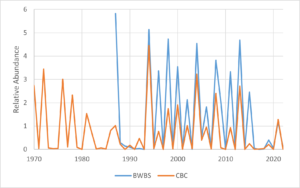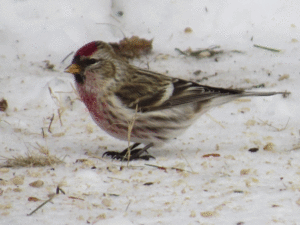(Story and photos by Pam Hunt)
Have you seen a Common Redpoll (Acanthis flammea) at your feeders this winter? If so, there’s a very good chance you live north of the White Mountains, and even then you may only have seen a handful of these active little finches.
In the fall of 2022 I predicted a very different scenario, one which unfortunately has yet to come to pass. As shown in Figure 1, redpolls have a very clear biennial cycle, with high numbers one year followed by almost none the next. These are called “irruptions” and result when birds’ food supplies in their regular winter range are low, thus forcing them to move elsewhere in large numbers in search of better feeding grounds. For Common Redpolls, the drivers of the irruptions are spruce and birch seed crops in boreal Canada and Alaska where the species nests. These trees typically produce bumper crops every other year, and in the off years we expect the birds to show up much farther south – such as in the northeastern United States. If you look at the data in Figure 1, you see that the most recent winter (2021-22) was a down year for redpolls, meaning that 2002-23 should have given us a good irruption. Indeed, a bird observatory on the north shore of the St. Lawrence River in Quebec recorded thousands of redpolls migrating south during late October and November, and birders in northern New England were expecting an influx shortly thereafter.

Except so far it hasn’t happened. Looking at eBird records for the winter so far, there are very few redpolls (for an invasion year) anywhere in New Hampshire, and most reports have been in the single digits and birds haven’t stayed in a location for very long. The picture isn’t much better in neighboring states and provinces, although double-digit counts are a little more prevalent in VT and parts of southern Canada. Still, it appears that the thousands of fall migrants have disappeared into thin air.
Where could they have gone? I don’t have an answer to this question, other than the unsatisfying one of “where people aren’t seeing them.” Perhaps there is enough food out in the winter woods to the north that redpolls haven’t needed to visit feeders – or travel south of the White Mountains. All we can do is keep tracking their numbers, so you are strongly encouraged to participate in this month’s Backyard Winter Bird Survey (link below). Maybe more redpolls will have moved in as winter progresses or maybe not – the only way to find out is to keep counting and reporting.

State of the Birds at a Glance:
- Habitat: Shrublands, Developed, Spruce-Fir Forest (breeding)
- Migration: Short-distance
- Population trend: Declining
- Threats: Largely unknown
- Conservation actions: Make your yard safe for birds (keep cats indoors, prevent window collisions)
NH Audubon’s “Backyard Winter Bird Survey” will occur on February 11-12, 2023. Find details here, plus how to participate.
